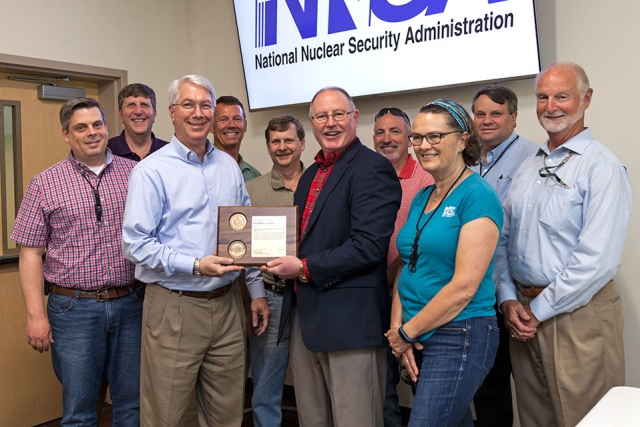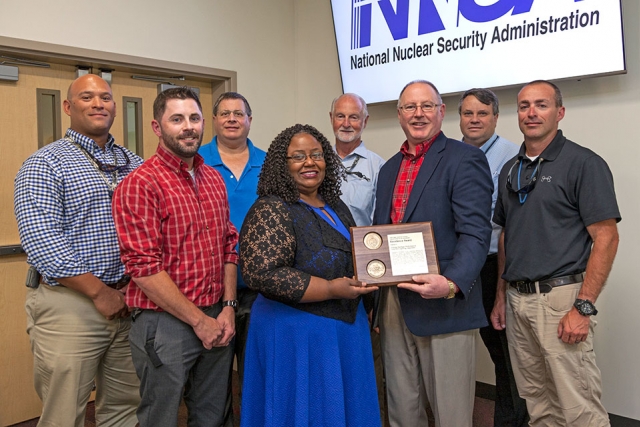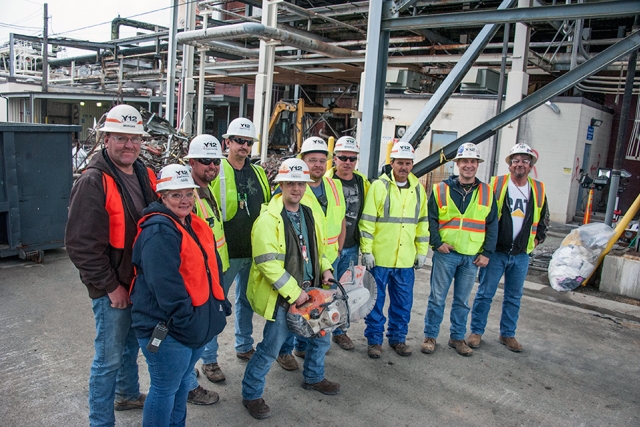Project teams honored by NA-50
 Building 9111 during demolition.
Building 9111 during demolition.
Four Y-12 project teams were recognized as fiscal year 2017 NA 50 Excellence Award winners. The projects included demolition of Buildings 9111/9112 and 9616-10, Energy Savings Performance Contract lighting upgrades, Building 9204-2 (Beta-2) Annex demolition, and Building 9201-05 (Alpha-5) Annex encapsulation. A fifth award was given to a joint Y-12/Pantex team for Construction Work Processes Improvements.
Jim McConnell, National Nuclear Security Administration’s Associate Administrator for Safety, Infrastructure and Operations, said, “NA-50 Excellence Award winners are recognized for outstanding accomplishments involving innovation, effectiveness, teamwork, overcoming adversity, and enabling future success. Your work in revitalizing our infrastructure will help support our missions for years to come.”
Demolition of Buildings 9111/9112 and 9616-10
Demolition work typically requires significant coordination between state and federal regulators, but the team that demoed three Y-12 buildings was able to gain regulatory approval in about 50 percent of the normal cycle times.
Kevin Lancaster, the team lead, said, “Through extraordinary teamwork, collaboration, and anticipating potential barriers, the team was able to complete the entire demolition in approximately 60 percent of the original baseline schedule and at about 75 percent of the baseline cost. We estimate the team’s actions saved approximately $1 million.”
Demolitions like these reduce overall risk for Y-12 and DOE/NNSA through eliminating the costs of managing these buildings and the associated worker safety issues they present.
 Members of the team who demolished Buildings 9111, 9112, and 9616-10 receive an Award of Excellence from Jim McConnell.
Members of the team who demolished Buildings 9111, 9112, and 9616-10 receive an Award of Excellence from Jim McConnell.
Y-12 Energy Savings Performance Contract lighting upgrades
Since FY 2016, Y-12 has used energy savings performance contracts to enhance building infrastructure, including an fiscal year 2016 project to modernize 11,450 lighting fixtures in 123 facilities, currently managed by Johnson Controls Government Services. The upgrades improved lighting conditions, reduced electricity use by 36 billion Btu per year, and saved more than $538,000 annually in energy costs.
The lighting upgrades were completed to allow for minimal disruption of production and operational mission critical priorities.
“We held regular team meetings and had good communications,” team lead Anna Beard said. “An innovative lockout/tagout procedure allowed the team to perform the work safely while saving time, effort, and money.”
The team also received the Secretary of Energy’s 2017 Federal Energy and Water Management Award for work completed by NPO, CNS, and Johnson Controls, Inc. It was the only group from DOE to receive this award in 2017.
 Members of the team that performed lighting upgrades for the Energy Savings Performance Contract receive an award from Jim McConnell, National Nuclear Security Administration’s Associate Administrator for Safety, Infrastructure and Operations.
Members of the team that performed lighting upgrades for the Energy Savings Performance Contract receive an award from Jim McConnell, National Nuclear Security Administration’s Associate Administrator for Safety, Infrastructure and Operations.
Y-12 Building 9204-2 Annex demolition
The mission work that Y-12 employees perform requires specialized equipment like Kathabar systems. These systems are needed in areas of Building 9204-2 to maintain critical temperature and humidity requirements.
Cliff Hastings, team lead, said, “We found the penthouse structure floor slab was severely degraded. So the best plan to access the floor slab for necessary repairs was to demolish the 9204-2 Annex, a concrete block building located beneath the penthouse, since the condition of the slab was expected to continue to deteriorate.”
The team completed demolition by using innovative barrier configurations to protect close, surrounding infrastructure.
“Our team worked together to ensure that numerous legacy systems were fully vetted without incident while we performed the isolation process,” Hastings said.
The project resulted in a cleared and usable surface that provides the most efficient and cost- effective means to access the underside of the penthouse. Access is allowing for much-needed inspections and repairs of the penthouse structure as required to maintain continued safe operation of mission-critical Kathabar systems.
 Shown are many of the team members who successfully completed demoing the Building 9204 2 Annex.
Shown are many of the team members who successfully completed demoing the Building 9204 2 Annex.
Building 9201-05 (Alpha 5) Annex encapsulation
Creativity and innovation are two characteristics often needed when working on a team, and the Building 9201 05 Annex encapsulation team demonstrated a unique approach in handling multiple issues. They created a single cost effective solution that also reduced the risk from radiological contamination and environmental insult inside.
“The benefits of this innovative approach reduced risks associated with the facility and the co located workers,” team lead Kevin Lancaster said. “Further benefits include allowing the project a broader range of demolition strategies enabling and enhancing future project success.”
 Jim McConnell, National Nuclear Security Administration’s Associate Administrator for Safety, Infrastructure and Operations (far right), presents an NA-50 Award of Excellence for Alpha-5 Annex Encapsulation.
Jim McConnell, National Nuclear Security Administration’s Associate Administrator for Safety, Infrastructure and Operations (far right), presents an NA-50 Award of Excellence for Alpha-5 Annex Encapsulation.
 National Nuclear Security Administration’s Associate Administrator for Safety, Infrastructure and Operations Jim McConnell (second from right) presents an Award of Excellence for Construction Work Processes Improvements.
National Nuclear Security Administration’s Associate Administrator for Safety, Infrastructure and Operations Jim McConnell (second from right) presents an Award of Excellence for Construction Work Processes Improvements.
